Effect of Ion Corrosion on 517 Phase Stability
Abstract
:1. Introduction
2. Experiment
2.1. Preparation of Raw Materials and Hardened Paste
2.2. Test Methods
2.2.1. Compressive Strength
2.2.2. Phase Composition
2.2.3. Microscopic Morphology and Pore Structure
3. Results
3.1. Characterization of Synthesized 517 Phase
3.2. Compressive Strength of Hardened Paste of 517 Phase
3.3. Transformation of 517 Phase in Chloride Solutions
3.4. Effect of Chloride Solutions on Microstructure and Pore Size Distribution of 517 Phase
4. Discussion
5. Conclusions
- The compressive strength of the 517 phase remained stable in NaCl, AlCl3, FeCl2, and FeCl3 solutions but decreased to 12.43 MPa after soaking in a CaCl2 solution for 28 days.
- Immersing the hardened paste in the CaCl2 solution caused the 517 phase to decompose into Mg(OH)2, MgSO4, and H2O. According to the second law of thermodynamics, Ca2+ preferentially reacted with SO42− to form gypsum, which broke the charge balance of the 517 phase and destroyed its laminar structure, thereby leading to 517 phase decomposition, as reflected by the decrease in 517 phase content in harden pastes and the obvious increase in concentrations of Mg2+ and SO42− in immersing solutions. When immersed in other chloride solutions, the 517 phase was stable and no new substance was formed.
- The formation of gypsum increased the content of large pores (>100 nm), while the decomposition of the 517 phase was accompanied by the appearance of some amorphous materials with poor crystallization, which enlarged the pore size (10–100 nm), thereby increasing the porosity of the hardened paste.
Author Contributions
Funding
Conflicts of Interest
References
- Walling, S.A.; Provis, J.L. Magnesium-based cements: A journey of 150 years, and cements for the future. Chem. Rev. 2016, 116, 4170–4204. [Google Scholar] [CrossRef]
- Runčevski, T.; Wu, C.Y.; Yu, H.F.; Yang, B.; Dinnebier, R. Structural characterization of a new magnesium oxysulfate hydrate cement phase and its surface reactions with at pheric carbon dioxide. J. Am. Ceram. Soc. 2013, 96, 3609–3616. [Google Scholar] [CrossRef]
- Zhou, X.; Li, Z. Light-weight wood–magnesium oxychloride cement composite building products made by extrusion. Constr. Build. Mater. 2012, 27, 382–389. [Google Scholar] [CrossRef] [Green Version]
- Dang, L.; Nai, X.Y.; Dong, Y.P.; Li, W. Functional group effect on flame retardancy, thermal and mechanical properties of organophosphorus-based magnesium oxysuflate whisker as a flame retardant in polypropylene. Rsc Adv. 2017, 7, 21655–21665. [Google Scholar] [CrossRef] [Green Version]
- Kahle, K. Mechanism formation of magnesium-sulfate cements. Silikatechnik 1972, 23, 148–151. [Google Scholar]
- Wu, C.; Yu, H.; Zhang, H.; Dong, J.; Wen, J.; Tan, Y. Effects of phosphoric acid and phosphates on magnesium oxysulfate cement. Mater. Struct. 2013, 48, 907–917. [Google Scholar] [CrossRef]
- Wu, C.Y. Fundamental Theory and Civil Engineering Application of Basic Magnesium Sulfate Cement. Ph.D. Thesis, The University of Chinese Academy of Sciences, Beijing, China, April 2014. [Google Scholar]
- Wu, C.; Yu, H.; Dong, J.; Zheng, L. Effects of Material Ratio, Fly Ash, and Citric Acid on Magnesium Oxysulfate Cement. ACI Mater. J. 2014, 111, 291–297. [Google Scholar] [CrossRef]
- Wang, N.; Yu, H.; Bi, W.; Tan, Y.; Zhang, N.; Wu, C.; Ma, H.; Hua, S. Effects of sodium citrate and citric acid on the properties of magnesium oxysulfate cement. Constr. Build. Mater. 2018, 169, 697–704. [Google Scholar] [CrossRef]
- Wu, C.; Chen, W.; Zhang, H.; Yu, H.; Zhang, W.; Jiang, N.; Liu, L. The hydration mechanism and performance of Modified magnesium oxysulfate cement by tartaric acid. Constr. Build. Mater. 2017, 144, 516–524. [Google Scholar] [CrossRef]
- Ba, M.; Xue, T.; He, Z.; Wang, H.; Liu, J. Carbonation of magnesium oxysulfate cement and its influence on mechanical performance. Constr. Build. Mater. 2019, 223, 1030–1037. [Google Scholar] [CrossRef]
- Zhao, J.Y.; Xu, J.H.; Cui, C.Y. Stability and phase transition of 517 phase in alkaline solutions. Constr. Build. Mater. 2020, 258, 119683. [Google Scholar] [CrossRef]
- Wang, R.; Qin, L.; Gao, X. Mechanical strength and water resistance of magnesium oxysulfate cement based lightweight materials. Cem. Concr. Compos. 2020, 109, 103554. [Google Scholar] [CrossRef]
- Gualtieri, A.F. Accuracy of XRPD QPA using the combined Rietveld–RIR method. J. Appl. Crystallogr. 2000, 33, 267–278. [Google Scholar] [CrossRef]
- Taylor, J.C. Computer programs for standard less quantitative analysis of minerals using the full powder diffraction profile. Powder Diffr. 1991, 6, 2–9. [Google Scholar] [CrossRef] [Green Version]
- He, P.; Poon, C.S.; Tsang, D.C. Comparison of glass powder and pulverized fuel ash for improving the water resistance of magnesium oxychloride cement. Cem. Concr. Compos. 2018, 86, 98–109. [Google Scholar] [CrossRef]
- Mo, L.; Deng, M.; Tang, M.; Al-Tabbaa, A. MgO expansive cement and concrete in China: Past, present and future. Cem. Concr. Res. 2014, 57, 1–12. [Google Scholar] [CrossRef]
- Li, X.; Tan, P.; Lu, W.; Liu, G.; Peng, Z.; Zhou, Q. Sintering process between kaolinite and alkali lime. JCCS 2006, 34, 422–426. [Google Scholar]
- Luong, V.-T.; Kang, D.J.; An, J.W.; Kim, M.J.; Tran, T. Factors affecting the extraction of lithium from lepidolite. Hydrometallurgy 2013, 134, 54–61. [Google Scholar] [CrossRef]
- Baquerizo, L.G.; Matschei, T.; Scrivener, K.; Saeidpour, M.; Wadsö, L. Hydration states of AFm cement phases. Cem. Concr. Res. 2015, 73, 143–157. [Google Scholar] [CrossRef]
- Li, D.; Zeng, D.; Yin, X.; Gao, D. Phase diagrams and thermochemical modeling of salt lake brine systems. III. Li2SO4 + H2O, Na2SO4 + H2O, K2SO4 + H2O, MgSO4 + H2O and CaSO4 + H2O systems. Calphad 2018, 60, 163–176. [Google Scholar] [CrossRef]
- Li, D.; Gao, D.; Dong, Y.; Li, W. Modeling of phase relations and thermodynamics in the Mg(OH)2 + MgSO4 + H2O system with implications on magnesium hydroxide sulfate cement. Calphad 2019, 67, 101675. [Google Scholar] [CrossRef]
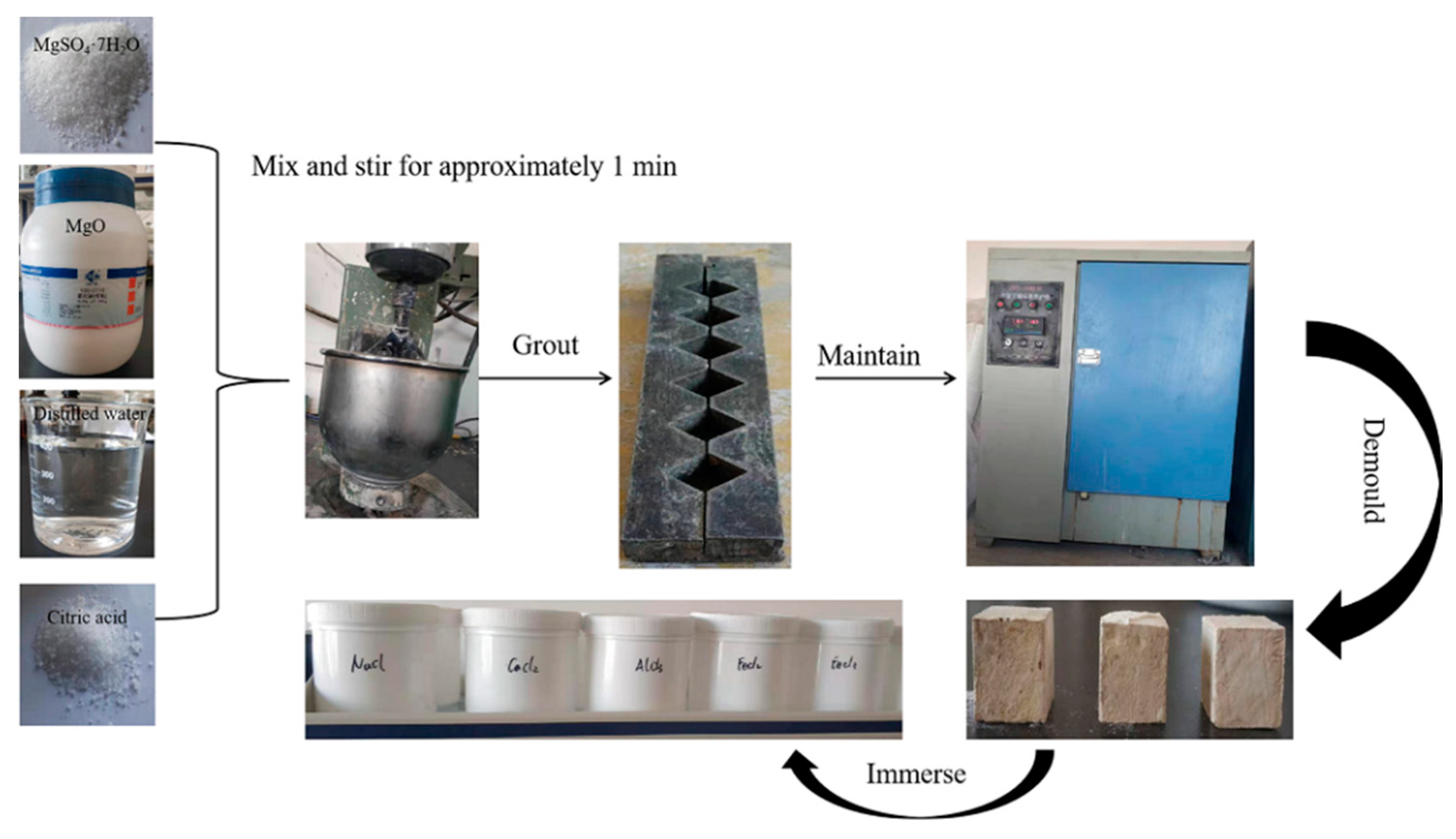
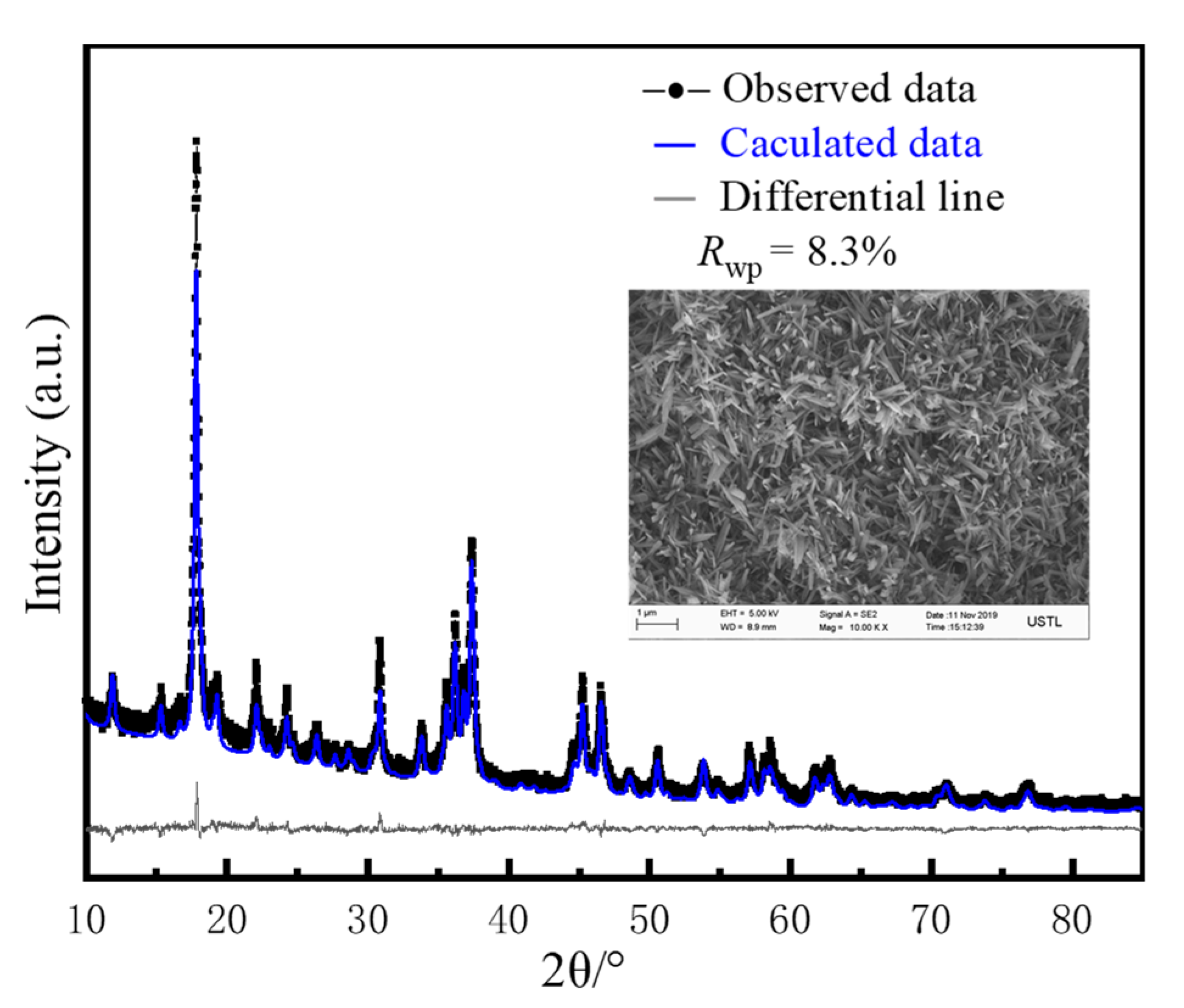
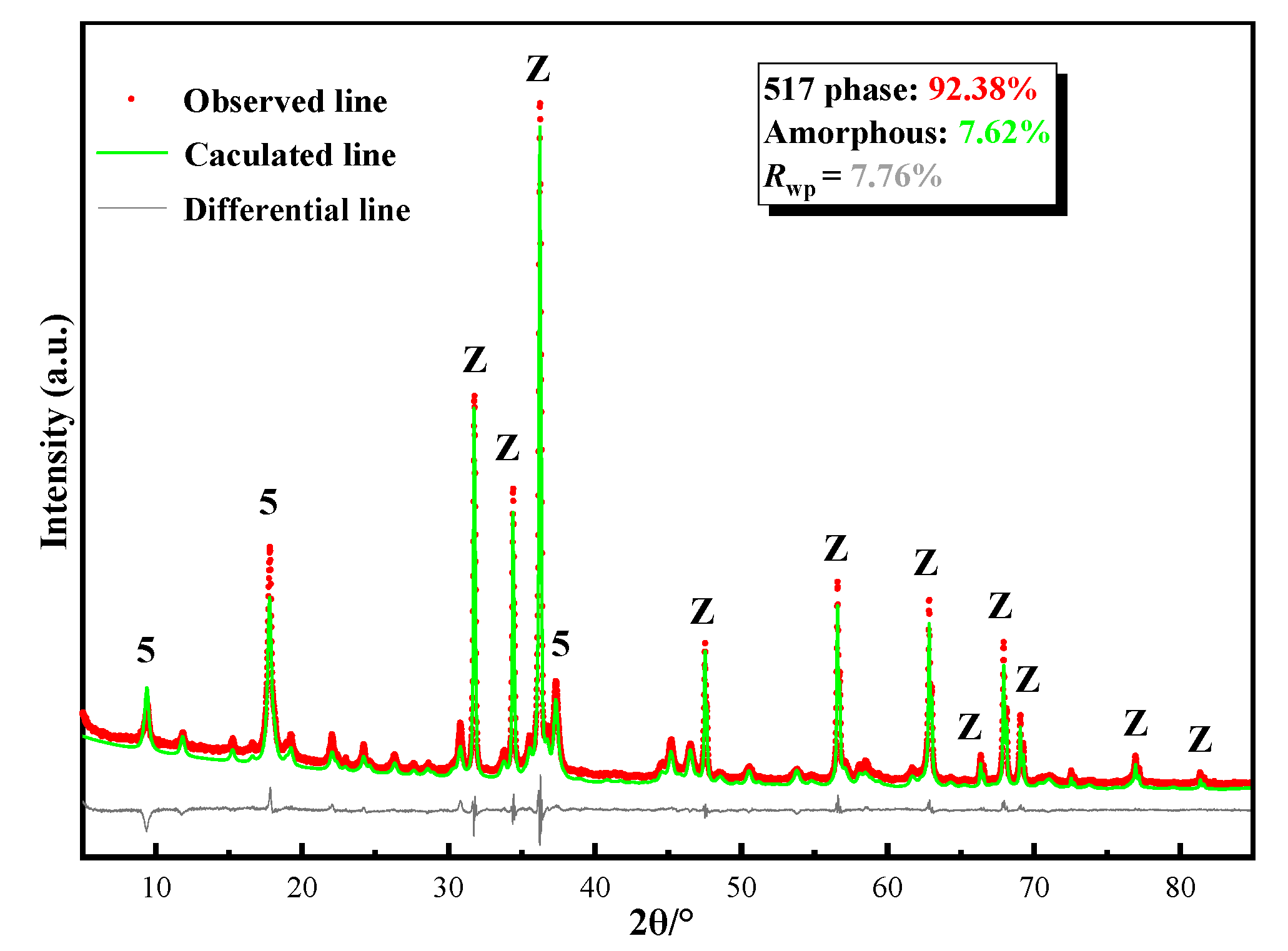

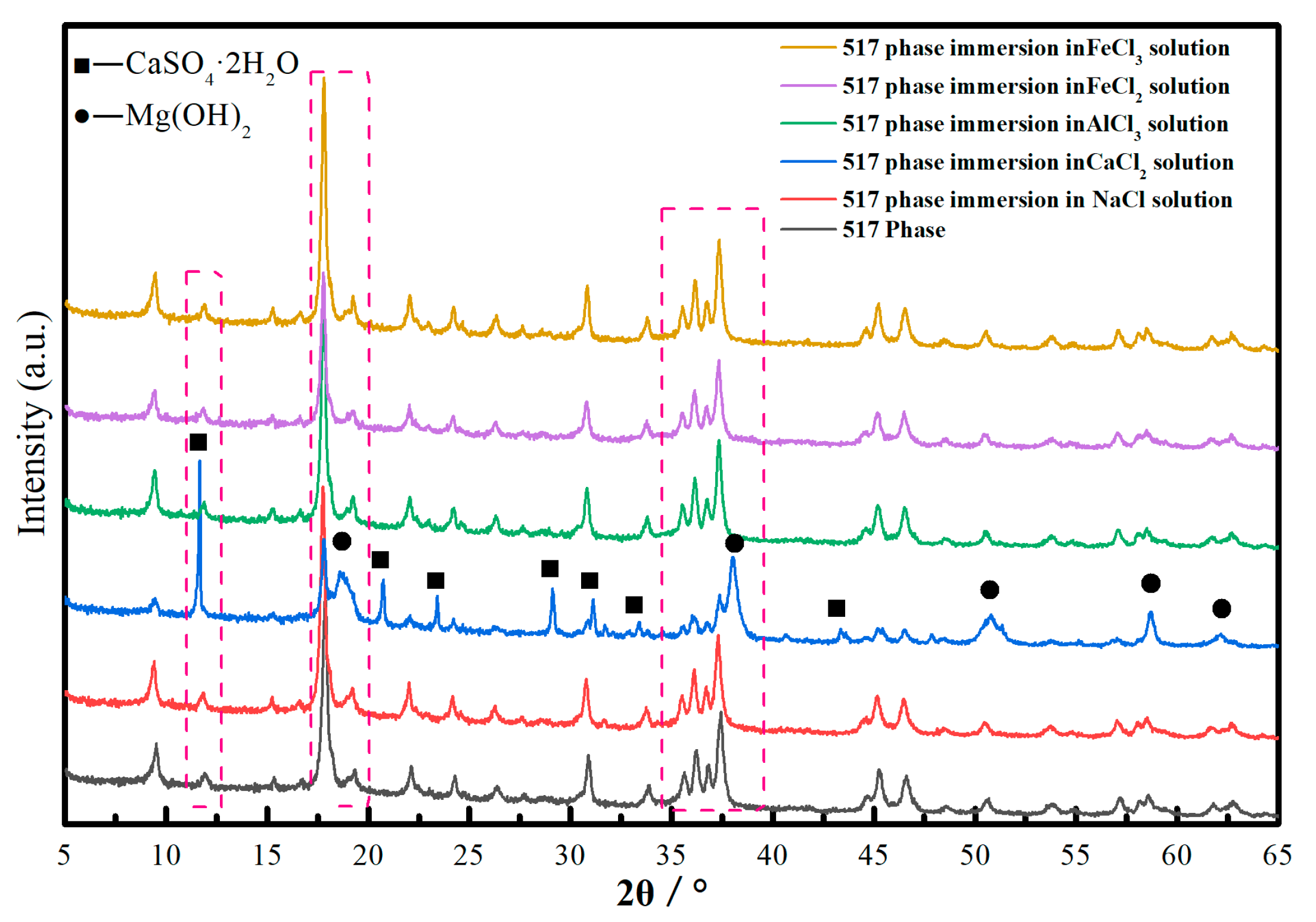
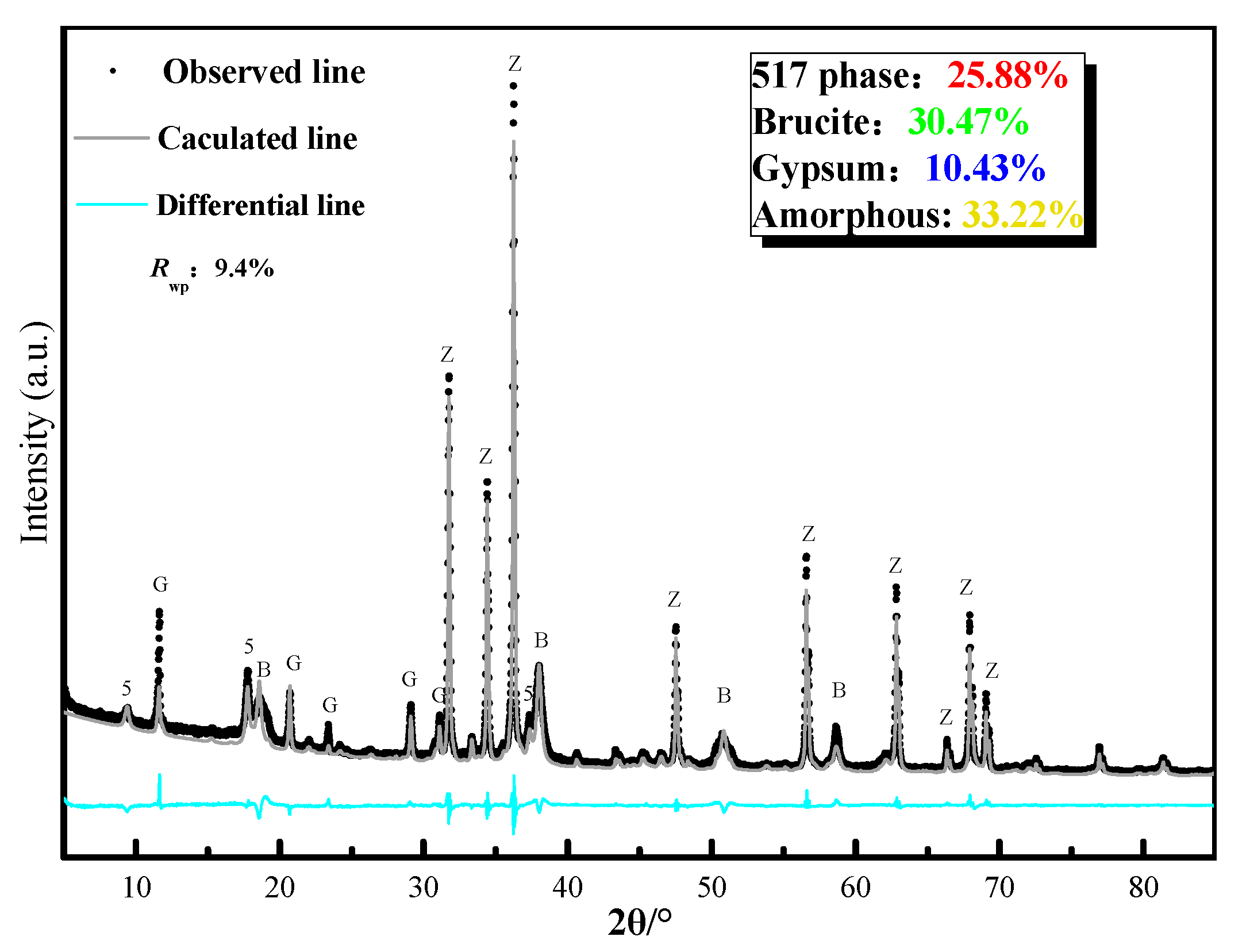
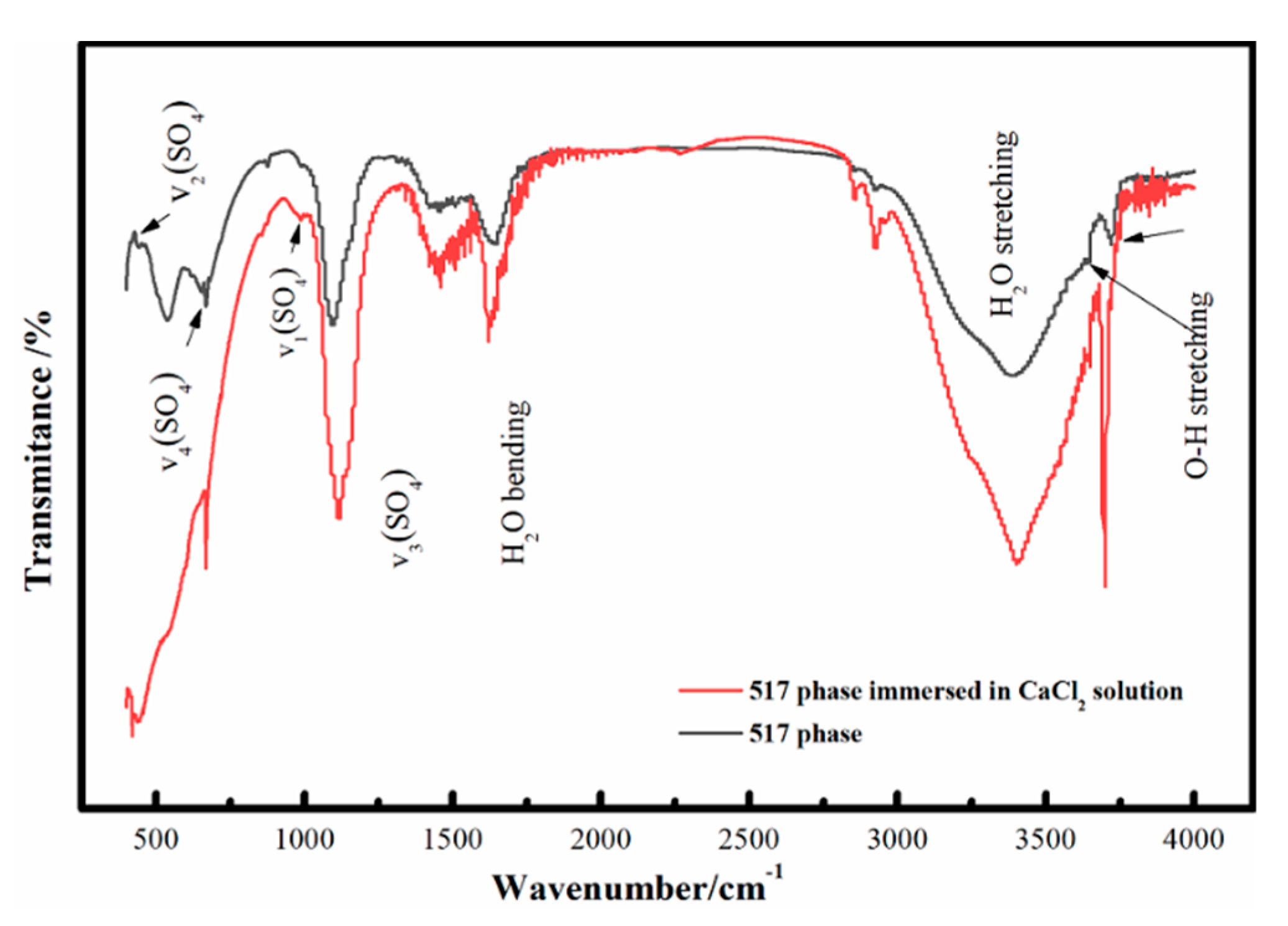
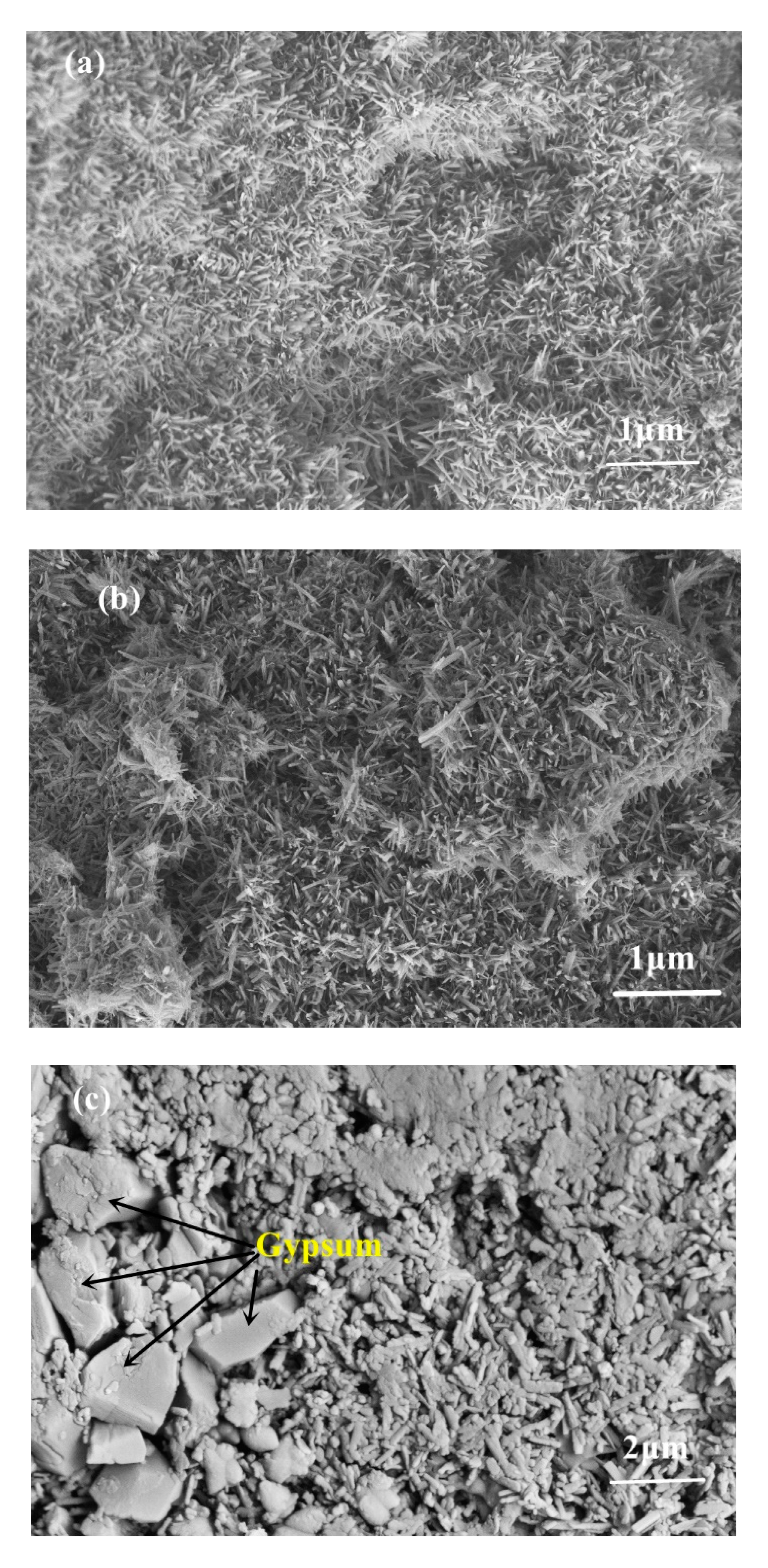
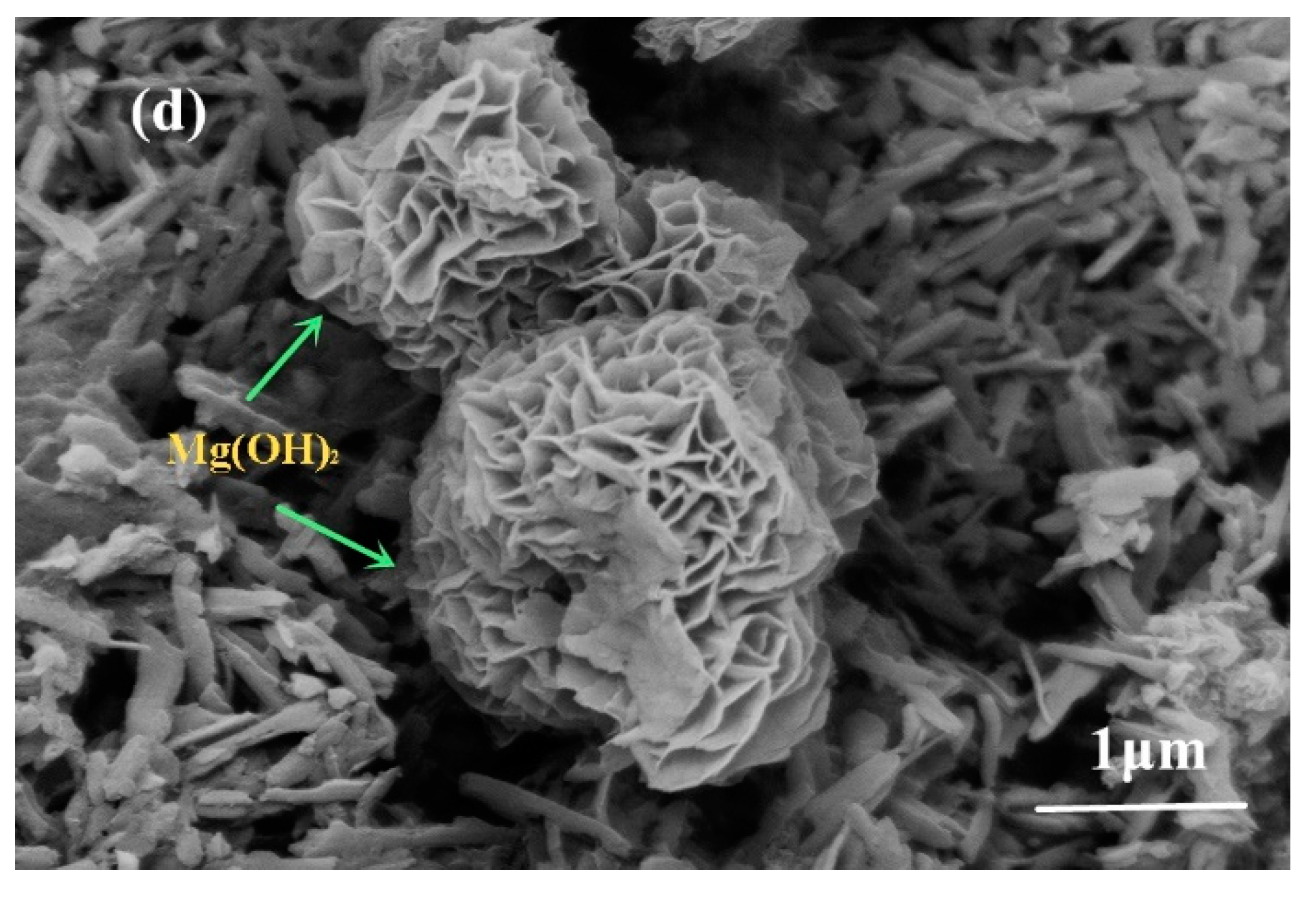
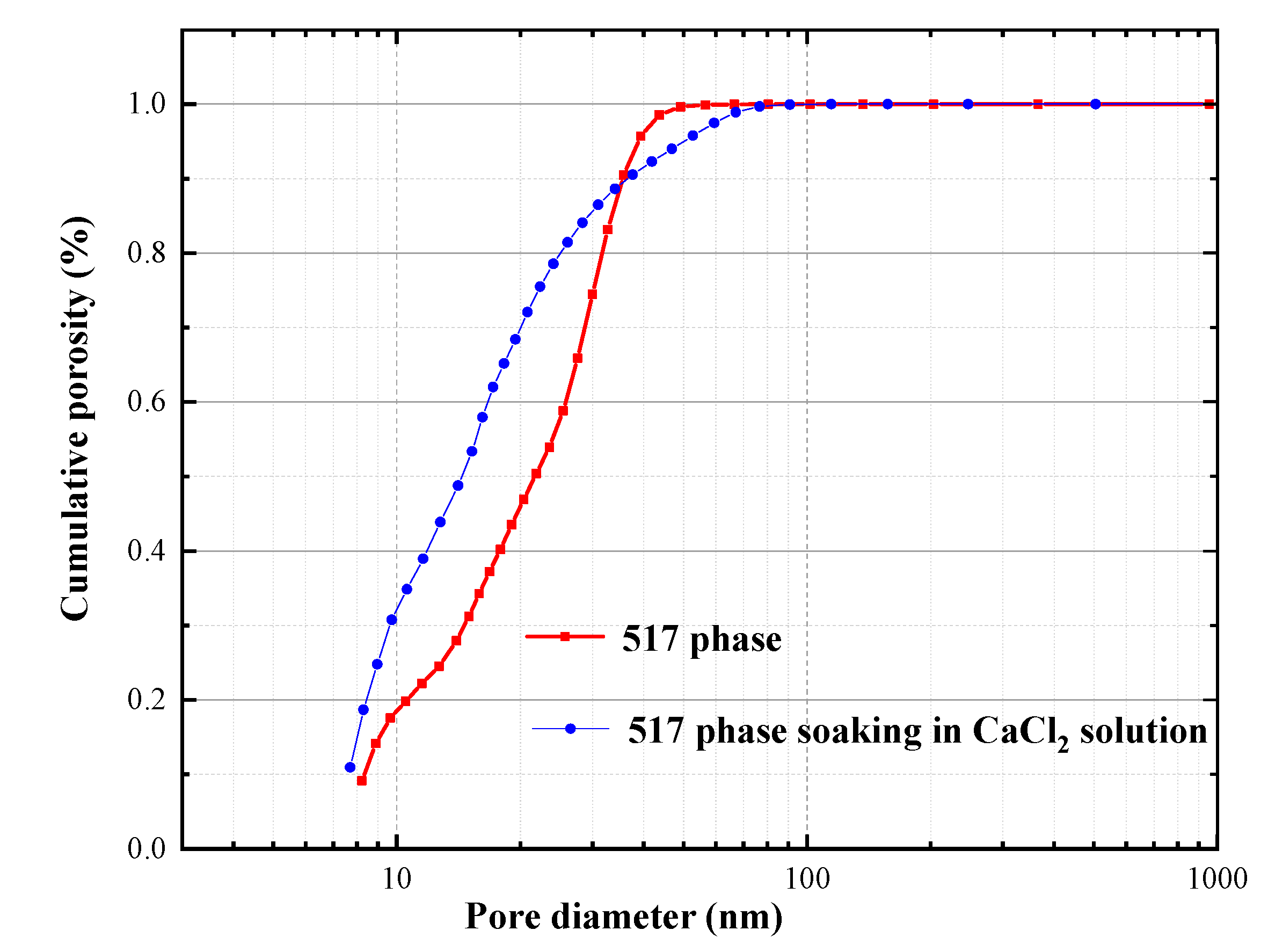

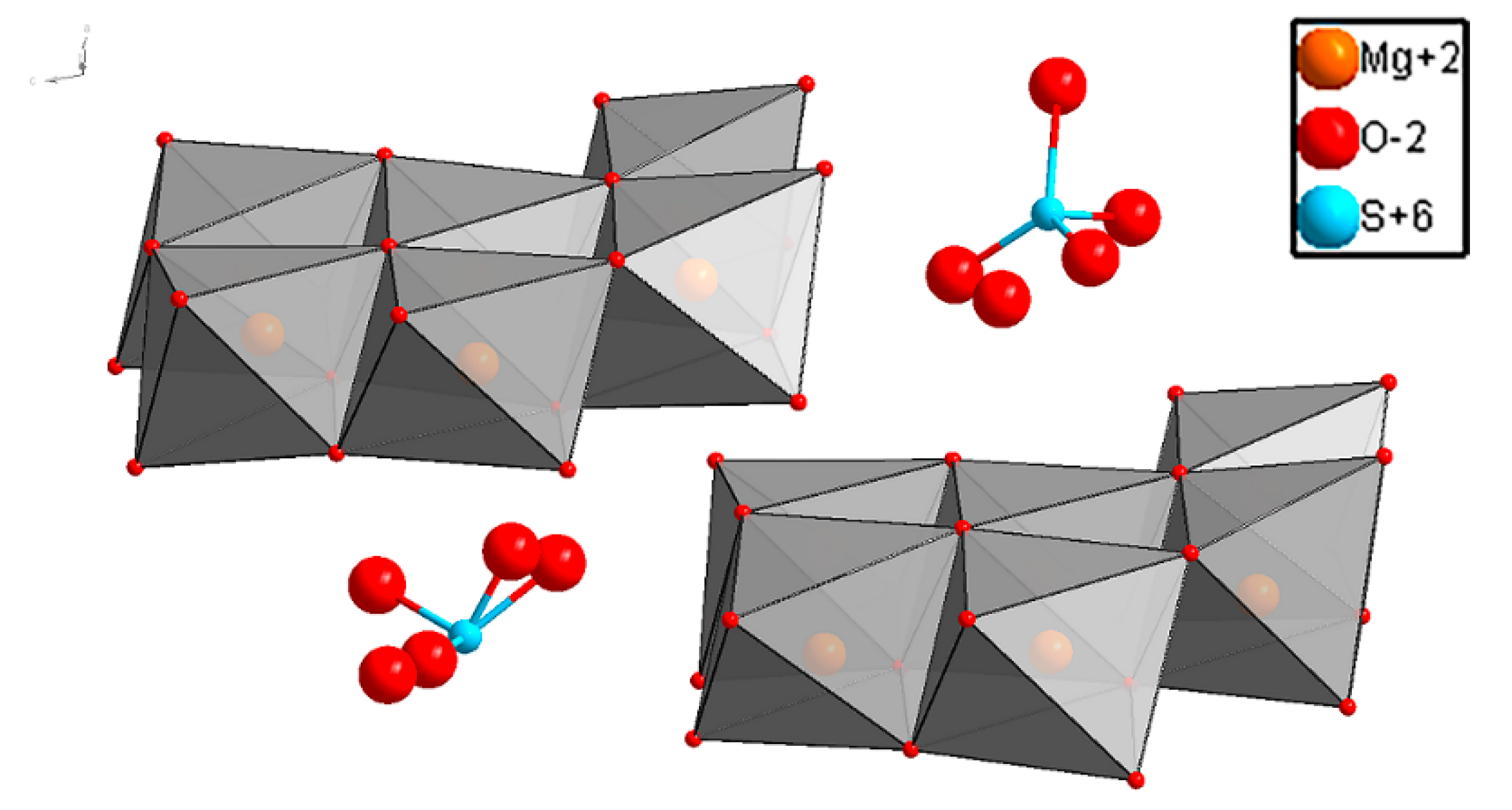
| Chloride Species | Phase Composition (wt.%) | |||
|---|---|---|---|---|
| 517 Phase | Mg(OH)2 | CaSO4·2H2O | Amorphous Content | |
| Before Soaking | 92.84 | 0 | / | 7.16 |
| NaCl | 92.03 | 0 | / | 7.97 |
| CaCl2 | 25.88 | 30.47 | 10.43 | 33.22 |
| AlCl3 | 91.48 | 0 | / | 8.52 |
| FeCl2 | 91.65 | 0 | / | 8.35 |
| FeCl3 | 91.78 | 0 | / | 8.22 |
| Chloride Species | NaCl | CaCl2 | AlCl3 | FeCl2 | FeCl3 |
|---|---|---|---|---|---|
| Mg2+ (mmol/L) | 3.97 | 37.43 | 4.03 | 3.87 | 3.93 |
| SO42− (mmol/L) | 0.63 | 32.48 | 0.67 | 0.66 | 0.64 |
| Solids | Ref. | |||
|---|---|---|---|---|
| Mg(OH)2 | −831.31 ± 0.11 | −921.62 ± 0.11 | 63.18 | [21] |
| 517 Phase | −7026.43 ± 7.40 | −7998.61 ± 3.60 | 674.32 ± 13.00 | [21] |
| CaSO4·2H2O | −1797.62 | −2032.44 | 162.55 | [22] |
| Ca2+ (aq) | −553.60 | −542.80 | −53.10 | [22] |
| H2O (l) | −237.13 | −285.83 | 69.91 | [22] |
| Mg2+ | −454.80 | −466.90 | −138.10 | [22] |
| SO42− (aq) | −744.50 | −909.30 | 210.10 | [22] |
Publisher’s Note: MDPI stays neutral with regard to jurisdictional claims in published maps and institutional affiliations. |
© 2020 by the authors. Licensee MDPI, Basel, Switzerland. This article is an open access article distributed under the terms and conditions of the Creative Commons Attribution (CC BY) license (http://creativecommons.org/licenses/by/4.0/).
Share and Cite
Wang, G.; Hu, Z.; Chang, J.; Guan, Y.; Zhang, T.; Bi, W. Effect of Ion Corrosion on 517 Phase Stability. Materials 2020, 13, 5659. https://doi.org/10.3390/ma13245659
Wang G, Hu Z, Chang J, Guan Y, Zhang T, Bi W. Effect of Ion Corrosion on 517 Phase Stability. Materials. 2020; 13(24):5659. https://doi.org/10.3390/ma13245659
Chicago/Turabian StyleWang, Guijia, Zhiqi Hu, Jun Chang, Yan Guan, Tingting Zhang, and Wanli Bi. 2020. "Effect of Ion Corrosion on 517 Phase Stability" Materials 13, no. 24: 5659. https://doi.org/10.3390/ma13245659
APA StyleWang, G., Hu, Z., Chang, J., Guan, Y., Zhang, T., & Bi, W. (2020). Effect of Ion Corrosion on 517 Phase Stability. Materials, 13(24), 5659. https://doi.org/10.3390/ma13245659






